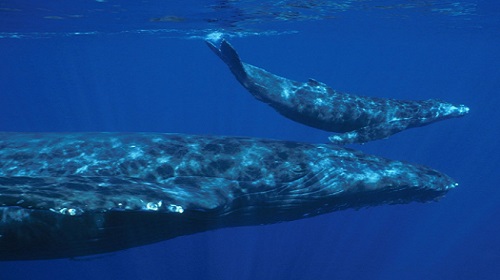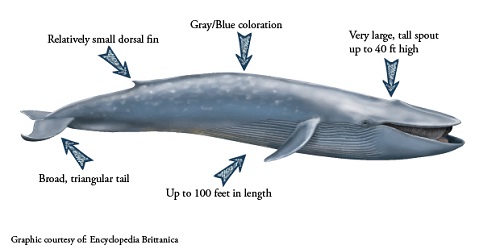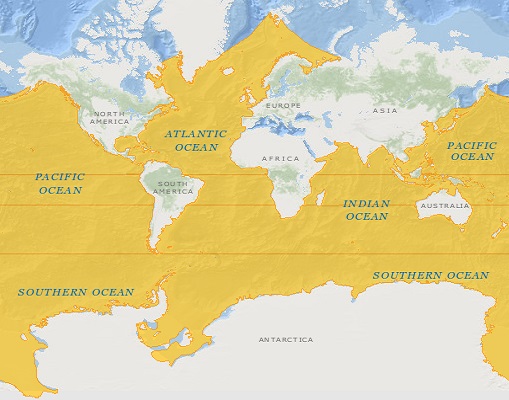Blue Whale are the largest animals to have ever existed on earth, due to its size there are no Blue Whales in captivity. These animals are also the loudest animals on earth. During the 20th century the species was almost exterminated due to commercial whaling. Blue Whales can be found in all major oceans of the world.

A Blue Whale and her calf
Name
- Common Name: Blue Whale, Pygmy Blue Whale. Antarctic Blue Whale. Great Northern Rorqual, Sibbald’s Rorqual.
- Scientific Name: Balaenoptera musculus. Balaenoptera comes from two Latin words Balaena meaning whale and pteron meaning fin. Musculus means mouse in Latin.
Conservation Status
- The Blue Whale was sought after for their blubber. In 1966 the International Whaling Commission declared them protected throughout the world.
- The IUCN Red List of Threatened Species lists the Blue Whale as Endangered.
- The species is listed under CITES Appendix II.
- Legal protection from commercial whaling under the International Convention for the Regulation of Whaling.
- In the US the Blued Whale is listed as endangered by the Endangered Species Act.
Taxonomy
- Kingdom: Animali

- Phylum: Chordata
- Class: Mammalia
- Order: Cetartiodactyla
- Suborder: Mysticeti
- Family: Balaenopteridae
- Genus: Balaenoptera
- Species: Balaenoptera musculus
0
0
Population and Migration
- It is estimated that the global population of Blue Whales is in the range of 10,000 to 25,000 or about 3 to 11% of the 1911 population.
- The migration of Blue Whales is not totally understood. Some populations are resident year round where food is widely available. Others migrate long distance to feeding grounds.
- The eastern group of the North Pacific population spend the winter in the coast of Mexico and Central America and the summer in California and British Columbia. The whales feeding off the coast of California is the largest concentration of Blue Whales in the world.
- The western group of the North Pacific population migrate from Kamchatka and the Gulf of Alaska to western and central Pacific including Hawaii.
- The western group of the North Atlantic population is found off Greenland, Newfoundland, Gulf of Saint Lawrence and Nova Scotia.
- The eastern group of the North Atlantic population is found from the Azores Islands to Iceland.
- In the Southern Hemisphere there are two groups: the Antarctic Blue Whale and the Pygmy Blue Whale in the Indian Ocean.
- Migratory patterns of Blue Whales are not well known.
Distribution and Habitat
- Blue Whales are found along the edge of the continental shelf in all major oceans of the world except for the Arctic and in sub polar and sub tropical altitudes.
- Populations of Blue Whales are distributed by ocean basin in the North Atlantic, North Pacific and Southern Hemisphere. Distribution is driven by food requirements where krill is concentrated.

Blue Whale Distribution Map. Map adapted from IUCN Red List of Threatened Species.
Physical Features
- The Blue Whale is a marine mammal belonging to the baleen whales. There are 15 species of baleen whales including humpback whales, right whales, gray whales and minke whales.
- The Blue Whale is the largest animal on earth. It weights up to 330,000 lb (150,000 kg) and is up to 110 feet (30 m) long.
- Females are larger than males.
- Its skin is mottled gray color and when seen through the water its skin appears light blue.
- Its body is long and streamlined with small dorsal fins and long and thin pectoral flippers.
- These whales have a row of 300 to 400 baleen plates in each side of their mouth, each plate measures around 3 ft (1 m) long.
- They also have 90 ventral grooves that reach the navel. They assist releasing the water after a lunge feeding.
- Blue Whales in the northern hemisphere are smaller than their counterparts in the Southern hemisphere.
Behavior
- The Blue Whale is the loudest animal on earth. Its call is louder than a jet engine, it reaches 188 decibels while the jet’s engine 140 decibels. The sounds that they make are low frequency pulses that serve as communication and echolocation.
- Their primary food source is krill and they can consume up to 4 tons a day during the feeding season. With each gulp they take their throat stretches through a series of ventral grooves which helps them get rid of all the water while keeping the krill trapped by baleen plates.
- When swimming they can reach speeds of up to 31 mph (50 km/h) in short bursts. When travelling they reach speeds of 12 mph (20 km/h).
- Blue Whales are usually seen alone unless is a female traveling with her calf. Concentrations in a small area can be observed when there is abundance of food.
Reproduction
- Blue Whales reach sexual maturity at around 10 years.
- Females reproduce every two to four years.
- Gestation lasts about 10 to 12 months.
- Mating and births take place during winter.
- Mother and calf form a very close bond. Calves are nursed for about 6 to 7 months.
- Blue Whale calves are born with a weight of approximately 5,000 to 6,000 lb (2,267 to 2,722 kg) and a length of 23 feet (7 meters).
- Blue Whale calves gain as much as 200 lb (90 kg) daily until they are weaned from their mother’s milk at around eight months.
Threats
- Whaling drastically reduced the whale population during the 1980s and 1990s.
- Habitat degradation, vessel strikes and disturbance, and sea pollution are some of the major threats facing Blue Whales.
Life Expectancy
- Scientists do not know exactly the life expectancy of Blue Whales but it is believed that they live up to 110 years.
References and Further Research
- International Whaling Commission
- Animal Aging and Longevity Database – Balaenoptera musculus
- National Oceanic and Atmospheric Administration Alaska Fisheries Center
- Marine Mammal Center – Blue Whale
- US Fish and Wildlife Service Endangered Species Act
- ITIS Report – Balaenoptera musculus
- American Museum of Natural History – The Giant Blue Whale Model
- IUCN Red List of Threatened Species – Balaenoptera musculus
- Convention on International Trade in Endangered Species of Wild Fauna and Flora
- University of Michigan Museum of Zoology – Balaenoptera musculus
- Australian Government Department of the Environment – Balaenoptera musculus
- Fisheries and Oceans Canada – Recovery Strategy for the Blue Whale, (Balaenoptera musculus) Northwest Atlantic Population, in Canada
- Smithsonian National Museum of Natural History – Balaenoptera musculus
